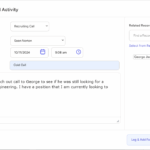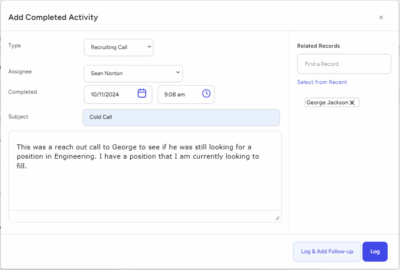The landscape of talent acquisition is evolving rapidly, driven by technological advancements and changing workforce dynamics. In this dynamic era, the role of recruiting tools has become paramount in attracting, assessing, and hiring top talent efficiently. From artificial intelligence (AI)-powered sourcing platforms to innovative candidate assessment tools, the recruiting industry is witnessing a revolution that promises to reshape how organizations identify and acquire the best candidates.
In this blog post, we will explore the top 10 recruiting tools that are redefining acquisition in 2023. These cutting-edge solutions leverage the latest advancements in technology to streamline the recruitment process, optimize candidate screening, and ultimately, enhance overall recruitment success. Whether you are a recruiter seeking to stay ahead of the competition or a hiring manager eager to secure top talent, these tools are indispensable in today’s competitive job market.
What Are Recruitment Tools?
Recruiting tools refer to a diverse set of software and technologies designed to streamline and enhance various aspects of the talent acquisition process. These tools are specifically developed to assist recruiters, hiring managers, and HR professionals in sourcing, assessing, and hiring the most suitable candidates for job vacancies within an organization.

Recruiting tools can also encompass candidate assessment software, video interviewing platforms, pre-employment testing platforms, and employee referral programs, among others. These tools not only save time and resources but also help identify the best-fit candidates, ultimately contributing to improved hiring outcomes and enhanced workforce productivity.
In a rapidly evolving job market, utilizing recruiting tools has become essential for organizations looking to attract and retain top talent, gain a competitive edge, and build a strong and diverse workforce that drives business success.
Benefits of Recruiting Tools
Recruitment is a critical process for any organization, as the success and growth of a company depend heavily on attracting and retaining top talent. In recent years, the evolution of technology has led to the development of innovative recruiting tools that have revolutionized the hiring landscape. These tools leverage artificial intelligence, machine learning, data analytics, and automation to streamline various aspects of the recruitment process, providing numerous benefits to both employers and job seekers. Below, we will explore the advantages of recruiting tools and how they have transformed the way organizations identify and hire the best-fit candidates.
Enhanced Candidate Sourcing and Screening
One of the primary benefits of recruiting tools lies in their ability to enhance candidate sourcing and screening. Traditional methods of recruitment often involve manually sifting through a vast number of resumes and applications, which can be time-consuming and inefficient. With recruiting tools, employers can leverage advanced algorithms and AI-driven technologies to identify potential candidates from diverse sources, including job boards, social media platforms, and professional networks.
These tools can analyze resumes and applications, filtering out candidates who do not meet the necessary criteria and presenting the most relevant ones to recruiters. By automating this process, recruiting tools significantly reduce the time and effort required to identify suitable candidates, allowing recruiters to focus their attention on engaging with the most promising individuals.
Improved Candidate Experience
Candidate experience plays a crucial role in shaping an organization’s reputation and employer brand. Recruiting tools have brought a positive transformation in this area by providing a seamless and personalized experience to job seekers. AI-powered chatbots and virtual assistants can engage with candidates in real-time, answering their queries, providing application status updates, and guiding them through the recruitment process.

Data-Driven Decision Making
Data is the backbone of effective recruitment, enabling organizations to make informed and objective hiring decisions. Recruiting tools harness the power of data analytics to provide valuable insights into various recruitment metrics, such as candidate sourcing channels, time-to-fill, cost-per-hire, and candidate conversion rates.
By analyzing this data, recruiters can identify patterns and trends, optimize their recruitment strategies, and make data-driven decisions to enhance the overall hiring process. This level of data-driven decision making empowers organizations to improve their recruitment efforts continually and align them with the evolving needs of the business.
Diversity and Inclusion Initiatives
Creating a diverse and inclusive workforce is a priority for many organizations, as it fosters creativity, innovation, and a broader range of perspectives. Recruitment tools play a pivotal role in supporting diversity and inclusion initiatives by reducing unconscious bias in the hiring process.
AI-driven tools can be programmed to focus solely on the qualifications and skills of candidates, disregarding personal information such as names, ages, and gender during initial screening. This blind hiring approach ensures that candidates are assessed solely on their merit, opening up opportunities for individuals from underrepresented backgrounds and promoting a more inclusive work environment.
Streamlined Interview Process
The interview stage is critical for evaluating a candidate’s suitability for a role and assessing their cultural fit within the organization. Recruitment tools offer various features that streamline the interview process, such as video interviewing platforms and interview scheduling tools.
Video interviews allow for greater flexibility in the hiring process, especially when dealing with remote or international candidates. They also enable employers to assess non-verbal cues and communication skills more effectively. Additionally, interview scheduling tools help coordinate interviews seamlessly, avoiding scheduling conflicts and delays, which can lead to a more efficient and timely recruitment process.
Talent Pool Management
Recruitment tools enable organizations to build and manage talent pools effectively. A talent pool consists of potential candidates who have shown interest in the company or have previously applied for a position. By utilizing applicant tracking systems (ATS) and candidate relationship management (CRM) tools, employers can maintain a database of candidates for future job openings.
This proactive approach allows recruiters to tap into a pre-qualified pool of talent, reducing time-to-fill and minimizing recruitment costs. Moreover, it fosters a continuous relationship with potential candidates, making it easier to reach out to them when relevant opportunities arise.
The Top 10 Recruiting Tools for 2023
Recruitment tools have emerged as indispensable assets for organizations seeking to optimize their hiring processes and attract top talent. As technology continues to advance, the capabilities of recruitment tools will only grow, empowering recruiters to make smarter, faster, and more inclusive hiring decisions.
Embracing these tools is no longer an option but a necessity for organizations looking to thrive in an increasingly competitive job market. By harnessing the power of recruiting tools, companies can build robust and diverse teams that drive innovation and success in the ever-evolving business landscape.
With this firmly in mind, below are the top 10 recruiting tools for 2023:
1. Applicant Tracking Software
Applicant tracking software is a powerful and essential recruiting tool that has transformed the way organizations manage their hiring process. Designed to streamline and optimize recruitment efforts, ATS automates various aspects of candidate sourcing, application tracking, and hiring, leading to increased efficiency and improved candidate management.
Applicant tracking software serves as the central hub for recruiters and hiring teams to manage the entire recruitment lifecycle. Its primary function is to collect, organize, and track job applications from various sources, such as job boards, career websites, and social media platforms. With ATS, manual handling of resumes and applications becomes a thing of the past, as it automates the process of screening and shortlisting candidates based on predefined criteria.
Through ATS, recruiters can create customized job postings and distribute them to multiple platforms with ease. As applications pour in, the software uses AI-driven algorithms to parse resumes, extracting key information and populating it into a centralized database. This allows recruiters to search and filter through candidates based on specific keywords, skills, qualifications, or experience, significantly reducing the time and effort required for candidate sourcing.
Furthermore, ATS facilitates seamless collaboration among hiring teams by providing a shared platform to review and rate candidates, leave feedback, and make data-driven decisions. It ensures that all stakeholders are on the same page throughout the hiring process, leading to more transparent and efficient recruitment.
Another crucial feature of ATS is its ability to enhance the candidate experience. By sending automated email updates and acknowledgments, ATS keeps candidates informed about their application status, ensuring timely and respectful communication. This not only strengthens the employer brand but also encourages candidates to maintain a positive impression of the organization.
2. Job Boards
Job boards have become an essential and widely used recruiting tool for both employers and job seekers in today’s digital age. These online platforms serve as virtual marketplaces, connecting employers with potential candidates and providing a convenient and efficient way to advertise job openings and search for employment opportunities.

For job seekers, job boards offer a centralized and user-friendly platform to search for jobs across various industries and locations. They can easily filter job listings based on their preferences, such as job title, location, salary range, and experience level, making it simpler to find the most suitable positions. Furthermore, job boards often feature advanced search functionalities and job alert systems, which notify candidates about new job postings that match their criteria, enhancing their chances of discovering relevant opportunities.
Job boards also facilitate streamlined communication between employers and candidates. Once a candidate applies for a job, their application and resume are typically sent directly to the employer or integrated into an Applicant Tracking System (ATS). This efficient process enables recruiters to review and shortlist candidates quickly, expediting the hiring process.
Additionally, job boards often provide value-added resources such as career advice, resume writing tips, and interview preparation guidance, benefiting job seekers in their job search journey.
3. Chatbots
Chatbots have emerged as a cutting-edge and invaluable recruiting tool, leveraging artificial intelligence to engage with candidates, provide real-time support, and enhance the overall recruitment experience. These conversational agents have transformed the way organizations interact with potential hires, streamlining communication, and automating routine tasks.
Chatbots in recruiting serve as virtual assistants that engage with candidates at various stages of the hiring process. When integrated into career websites or social media platforms, chatbots can initiate conversations with visitors, answering their questions about job opportunities, company culture, and application procedures. This instant and personalized support enhances the candidate experience, providing quick access to information and keeping potential candidates engaged.
One of the main benefits of chatbots is their ability to handle a high volume of queries simultaneously. Unlike human recruiters who have limitations in terms of availability and response time, chatbots can work 24/7, responding to candidate inquiries promptly. This ensures that no candidate is left waiting for a response, even outside regular business hours, significantly improving the efficiency of the recruitment process.
Moreover, chatbots can pre-screen candidates by asking relevant questions and gathering essential information such as skills, experience, and availability. This initial screening helps recruiters identify the most suitable candidates and focus their efforts on engaging with the best-fit individuals.
Chatbots can also conduct initial interviews with candidates, using natural language processing to analyze responses and assess their qualifications. By conducting these automated interviews, recruiters can save time and effort in the early stages of candidate evaluation, freeing up more time for in-depth interviews with shortlisted candidates.
Furthermore, chatbots can maintain ongoing communication with candidates, providing updates on their application status, scheduling interviews, and sending reminders. This continuous engagement keeps candidates informed and interested throughout the recruitment process, strengthening the employer brand and leaving a positive impression on potential hires.
4. Video Interviews
Video interviews have emerged as a powerful and efficient recruiting tool that has transformed the way organizations conduct candidate assessments and streamline the hiring process. This technology-driven approach allows employers to connect with candidates remotely, providing numerous benefits for both recruiters and job seekers.

One of the key advantages of video interviews is the ability to assess a candidate’s communication skills and non-verbal cues more effectively. During video interviews, recruiters can observe candidates’ body language, facial expressions, and overall demeanor, providing valuable insights into their level of confidence and professionalism. This additional layer of evaluation complements the traditional interview process, allowing employers to make more informed hiring decisions.
Video interviews also foster a more inclusive hiring process, as they accommodate candidates with diverse needs and circumstances. For instance, individuals with disabilities or those facing logistical challenges can participate in video interviews without the need for extensive travel. This inclusivity reinforces an organization’s commitment to diversity and accessibility.
Furthermore, video interviews can be recorded and shared with other members of the hiring team for collaborative evaluations. This feature ensures that all stakeholders are involved in the decision-making process, promoting a more comprehensive and objective assessment of candidates.
Lastly, video interviews shorten the hiring timeline by eliminating scheduling conflicts and reducing the time needed for initial screenings. Recruiters can review and compare video interviews at their convenience, expediting the candidate shortlisting process and accelerating time-to-hire.
5. LinkedIn
LinkedIn has revolutionized the recruitment landscape, emerging as a premier professional networking platform and a valuable recruiting tool for employers and job seekers alike. With its vast user base of professionals from various industries and its robust suite of features, LinkedIn has become an indispensable resource for talent acquisition and employer branding.
LinkedIn serves as a virtual marketplace for professionals, allowing employers to showcase their brand and job opportunities to a massive and diverse talent pool. Through company profiles, organizations can provide insights into their culture, values, and achievements, creating a compelling employer brand that attracts top talent. Additionally, LinkedIn’s job posting feature enables companies to advertise their openings to millions of potential candidates, making it a cost-effective and efficient means of recruitment.
The platform’s advanced search and filtering capabilities make candidate sourcing seamless and precise. Recruiters can use specific keywords, job titles, skills, and other criteria to identify candidates who best match their requirements. This targeted approach helps organizations focus on engaging with the most relevant candidates, reducing time-to-fill and improving the quality of hires.
LinkedIn’s InMail feature facilitates direct and personalized communication with potential candidates, bypassing the constraints of traditional channels. Recruiters can send tailored messages to candidates of interest, inviting them to explore job opportunities and engage in discussions. This personalized outreach enhances the candidate experience and increases the likelihood of attracting passive candidates who may not actively be seeking new roles.
Moreover, LinkedIn serves as a comprehensive talent database, allowing employers to access rich candidate profiles with detailed work history, recommendations, endorsements, and professional achievements. This wealth of information aids recruiters in making informed decisions about a candidate’s suitability for a particular role.
Beyond candidate sourcing, LinkedIn enables employers to build and nurture relationships with potential candidates through content marketing. By sharing relevant and engaging content, organizations can establish thought leadership, demonstrate their industry expertise, and cultivate a following of talented professionals who may consider future opportunities within the company.
6. Assessment and Testing
Assessment and testing have become crucial recruiting tools for organizations seeking to make data-driven and informed hiring decisions. These tools offer a systematic and objective approach to evaluate candidates’ skills, knowledge, and suitability for specific roles, helping employers identify the best-fit individuals for their teams.
Assessment and testing allow employers to go beyond resumes and interviews, providing a deeper understanding of a candidate’s capabilities and potential. Depending on the role, various assessment methods can be utilized, such as technical skills tests, cognitive ability assessments, personality assessments, situational judgment tests, and job simulations. These assessments provide insights into a candidate’s problem-solving skills, communication abilities, emotional intelligence, and cultural fit within the organization.
One of the primary benefits of using assessments in the recruitment process is the ability to standardize evaluation criteria. By administering the same tests to all candidates, employers can ensure a fair and consistent evaluation, eliminating bias and subjectivity in the hiring process. This objectivity helps organizations identify the most qualified candidates based on their merit and qualifications.
Assessments also assist in predicting a candidate’s job performance, reducing the risk of hiring candidates who may not be a good fit for the role or the organization’s culture. By using validated and job-related assessments, employers can identify candidates with the skills and attributes necessary for success in the position.
Furthermore, assessments help organizations save time and resources by enabling more efficient candidate screening. Employers can use assessments as an initial screening tool to shortlist candidates for further evaluation through interviews and other assessments. This focused approach ensures that only the most qualified candidates proceed to the later stages of the hiring process.
Assessment and testing also play a role in the ongoing development of employees. By conducting regular assessments and performance evaluations, employers can identify areas of improvement and provide targeted training and development opportunities, leading to a more skilled and productive workforce.
7. Recruitment CRM
Recruitment Customer Relationship Management (CRM) is a powerful and strategic recruiting tool that empowers organizations to effectively manage their talent acquisition efforts and build lasting relationships with candidates. Based on the CRM principles widely used in sales and marketing, recruitment CRM focuses on engaging, nurturing, and converting candidates into successful hires.
Recruitment CRM serves as a centralized platform to store and manage candidate data and interactions throughout the entire recruitment lifecycle. It allows employers to capture candidate information from various sources, such as career websites, job boards, social media, and referrals. By organizing and consolidating candidate data, recruitment CRM enables recruiters to access a comprehensive view of their talent pool and streamline their communication.

Recruitment CRM also supports proactive talent sourcing and talent pool management. Recruiters can segment their candidate database based on skills, qualifications, experience, and other criteria, allowing for targeted outreach when relevant opportunities arise. This proactive strategy helps employers maintain a pipeline of potential candidates, reducing time-to-fill and optimizing the recruitment process.
Another significant benefit of recruitment CRM is the ability to track and measure recruitment metrics. Employers can analyze data on candidate engagement, conversion rates, time-to-hire, and other key performance indicators. This data-driven approach enables recruiters to make data-backed decisions, optimize their recruitment strategies, and identify areas for improvement.
Additionally, recruitment CRM facilitates collaboration among the hiring team. Recruiters and hiring managers can share notes, feedback, and candidate evaluations, promoting a seamless and transparent recruitment process.
8. Past Applicants
Using past applicants as a recruiting tool is a smart and often underutilized strategy that can yield significant benefits for organizations. These candidates have already shown interest in the company and have some level of familiarity with the organization’s values and culture. Leveraging past applicants can streamline the recruitment process, enhance candidate experience, and ultimately lead to more successful hires.
Improved Efficiency: Past applicants have already gone through the initial stages of the application process, and their information is likely stored in the organization’s applicant tracking system (ATS) or recruitment CRM. By revisiting this pool of candidates, recruiters can save time and effort in sourcing new applicants, as they are working with a pre-qualified group of individuals who have already expressed interest in the company.
Enhanced Candidate Experience: When reaching out to past applicants, organizations demonstrate that they value and appreciate their interest in the company. This proactive approach showcases a commitment to providing a positive candidate experience, even if they were not selected for a previous position. The personalized outreach to past applicants can also serve as a means of re-engaging candidates who may have been on the fence about joining the company.
Cost-Effectiveness: Utilizing past applicants as a recruiting tool can be cost-effective, as it reduces the need for expensive job postings and external sourcing efforts. Re-engaging candidates from the existing talent pool requires minimal investment while potentially yielding excellent results.
Stronger Talent Pipeline: Maintaining a talent pipeline is essential for any organization looking to hire quickly and efficiently when new positions open up. Past applicants can be nurtured and engaged regularly, creating a pool of potential candidates who are familiar with the company and ready to be considered for future opportunities.
Diverse Talent Pool: By revisiting past applicants, employers have the opportunity to diversify their talent pool. This approach allows them to reconsider candidates who may not have been the right fit for previous roles but could be well-suited for other positions within the organization.
9. Social Media
Using social media as a recruiting tool has become an integral part of modern talent acquisition strategies. With the widespread adoption of social platforms, organizations have access to a vast pool of potential candidates. Leveraging social media for recruitment offers numerous benefits, ranging from increased reach and visibility to enhanced employer branding and candidate engagement.
Expanded Reach and Visibility: Social media platforms have billions of active users, making them an unparalleled channel for reaching a broad and diverse audience. By posting job openings on social media, organizations can tap into a massive talent pool, connecting with both active job seekers and passive candidates who may be open to new opportunities.
Targeted Sourcing: Social media platforms offer sophisticated targeting options that allow recruiters to narrow down their audience based on specific demographics, interests, skills, and job titles. This targeted approach ensures that job postings reach the most relevant and qualified candidates, maximizing the chances of finding the right fit for the role.
Enhanced Employer Branding: Social media provides a platform for organizations to showcase their company culture, values, and work environment. By sharing engaging content, employee testimonials, and behind-the-scenes glimpses, employers can build a strong employer brand that attracts top talent and fosters a positive reputation in the job market.
Interactive Candidate Engagement: Social media facilitates direct and real-time communication with candidates. Recruiters can engage with potential hires through comments, direct messages, and live chats, providing personalized support and answering their queries promptly. This interactive engagement creates a positive candidate experience and helps nurture relationships with potential candidates.
Employee Referral Programs: Social media enables organizations to leverage their employees as brand ambassadors. By encouraging employees to share job postings and company updates on their social networks, companies can amplify their reach and attract candidates who have already been vetted by existing employees.
Showcasing Company Culture: Social media allows organizations to showcase their culture through images, videos, and stories, giving candidates a glimpse of what it’s like to work at the company. This transparency helps candidates assess their fit within the organization and increases the likelihood of attracting individuals who align with the company’s values.
10. Referral Program
Using a referral program as a recruiting tool is a powerful and effective strategy for organizations looking to attract top talent while leveraging their existing employees as brand ambassadors. Referral programs encourage employees to refer potential candidates from their network for open positions within the company. This approach has numerous advantages, including increased candidate quality, reduced time-to-hire, and enhanced employee engagement.
Improved Candidate Quality: Employee-referred candidates tend to be of higher quality compared to candidates from other sources. Since employees understand the company’s culture, values, and job requirements, they are more likely to refer individuals who align well with the organization and the role. This results in a higher probability of finding candidates who are a good fit and can contribute to the company’s success.

Cost-Effectiveness: Referral programs are cost-effective compared to traditional recruitment methods. By leveraging their employees’ networks, organizations can reduce spending on expensive job advertisements and external recruitment agencies. Incentives provided for successful referrals are often more affordable than other recruitment costs.
Enhanced Employee Engagement: Referral programs contribute to increased employee engagement and satisfaction. When employees are actively involved in the hiring process, they feel a stronger sense of ownership and loyalty toward the organization. Additionally, successful referrals can be recognized and rewarded, further boosting employee morale.
Positive Impact on Company Culture: Referral programs foster a culture of collaboration and teamwork. When employees participate in the recruitment process by referring candidates, they become brand advocates and actively contribute to building a cohesive and positive work environment.
Increased Diversity and Inclusion: Referral programs can be designed to prioritize diversity and inclusion efforts. By encouraging employees to refer candidates from diverse backgrounds, organizations can create a more inclusive and representative workforce.
Harness the Power of Top Echelon’s Recruiting Tools
Are you looking to streamline your recruiting process, access a vast network of top-notch candidates, and make data-driven hiring decisions? Look no further than Top Echelon Software, a comprehensive recruiting tool that empowers you to take your talent acquisition strategy to new heights. With its advanced features, user-friendly interface, and extensive candidate database, Top Echelon Software is the ultimate solution for modern recruiters seeking to excel in today’s competitive job market.
Benefits of Top Echelon Software
Extensive Candidate Database: Gain access to an extensive network of qualified candidates across various industries and skill sets. Top Echelon Software’s vast database allows you to source candidates quickly and efficiently, ensuring that you never miss out on top talent for your open positions.
Powerful Search and Filtering: Easily search and filter candidates based on specific criteria such as job title, location, experience level, and keywords. This targeted approach saves you time and effort, allowing you to focus on engaging with the most relevant candidates.
Automated Candidate Engagement: Keep candidates engaged throughout the hiring process with automated email campaigns and personalized communication. Top Echelon Software allows you to nurture relationships with candidates, providing updates on their application status and timely feedback.
Data-Driven Analytics: Make informed hiring decisions with data-driven insights and analytics. Top Echelon Software provides valuable recruitment metrics, such as candidate conversion rates, time-to-fill, and source effectiveness, helping you optimize your recruitment strategies for better results.
Mobile-Friendly Platform: Access Top Echelon Software on the go with its mobile-friendly platform. Stay connected with candidates and manage your recruitment efforts from anywhere, ensuring a seamless and efficient recruitment process.
Sign Up for a Demo of Top Echelon Software
Experience the power of Top Echelon Software firsthand by signing up for a live demo! Our team of experts will guide you through the platform’s features, demonstrate how it can revolutionize your recruitment efforts, and answer any questions you may have.
During the demo, you’ll learn how to:
- Utilize the extensive candidate database to find top talent for your job openings.
- Leverage powerful search and filtering options to identify the most qualified candidates.
- Integrate Top Echelon Software with your ATS for streamlined candidate management.
- Automate candidate engagement to ensure a positive candidate experience.
- Access data-driven analytics to make data-backed hiring decisions.
Don’t miss this opportunity to elevate your recruiting success with Top Echelon Software. Sign up for the demo today and unlock the potential of your talent acquisition strategy!
Click here to sign up for your live demo of Top Echelon. We look forward to showcasing the transformative capabilities of Top Echelon Software and helping you take your recruitment efforts to new heights!










